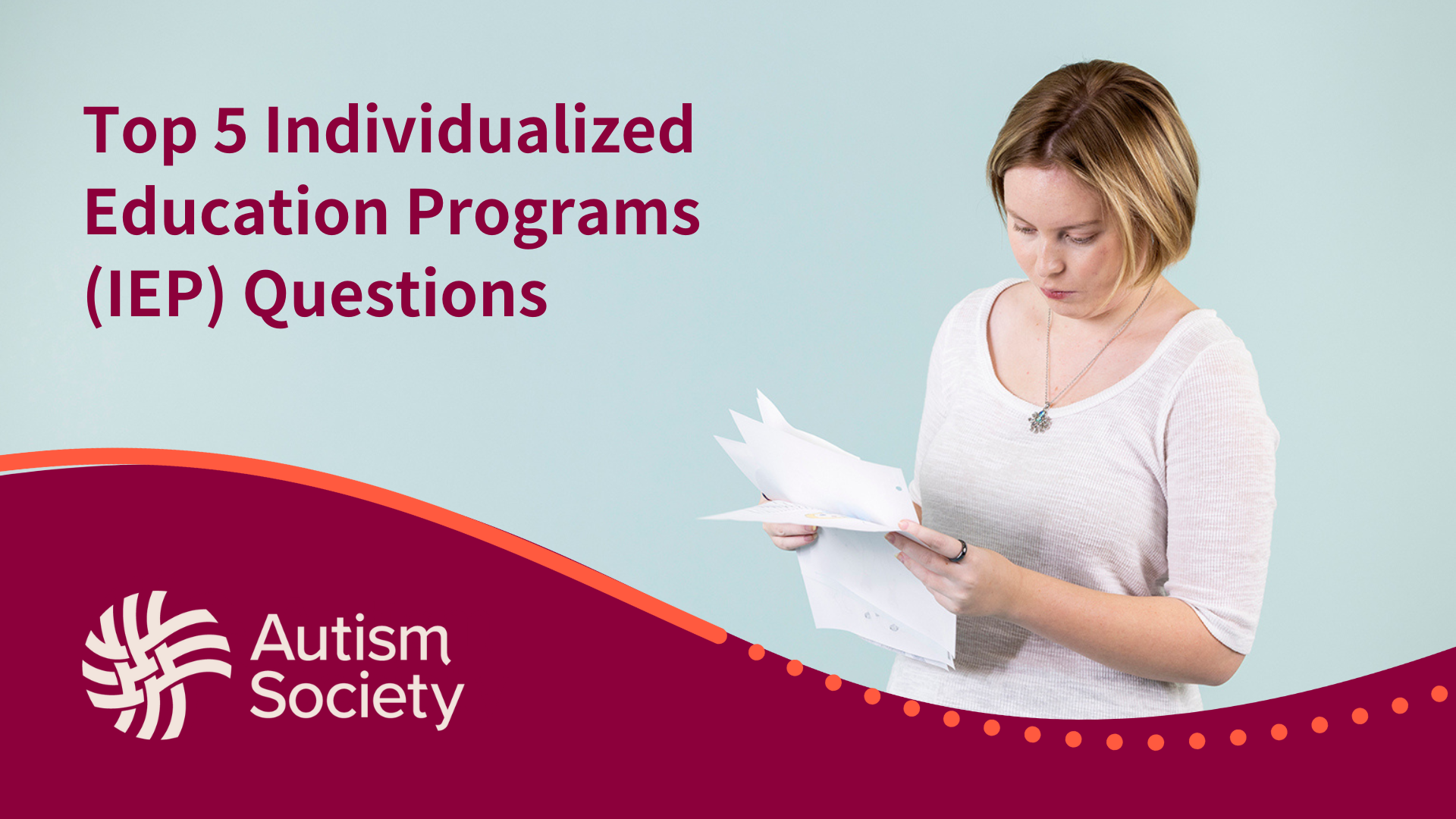
Top 5 Individualized Education Programs (IEP) Questions
At the Autism Society, we understand that navigating the IEP process can be daunting. This blog addresses the top five frequently asked questions about IEPs to help you advocate effectively for your child’s educational needs.
- How do I get my child assessed and obtain school support?
Initiating an assessment is crucial for securing appropriate support. Here’s how to start:
- Submit a Written Request: Write a formal letter to your child’s school principal or special education director requesting a comprehensive evaluation. Include any medical reports, teacher observations, or relevant documents supporting your request. Be sure to date and keep a copy of this letter.
- Understand the Timeline: After receiving your request, the school must respond within a “reasonable timeline” to obtain your consent for evaluation. Upon receiving consent, schools generally have 60 calendar days to complete the assessment. Note: The 60-day timeframe is guided by federal law under Individuals with Disabilities Education Act (IDEA), but some states may have different specific requirements. Check with your state’s department of education to learn more.
- Participate Actively in the Evaluation: Engage with the multi-disciplinary team conducting the evaluation. Provide relevant information and ask questions to clarify the process. Your insights as a parent are essential.
- Review the Results: After the assessments, the school will hold a meeting to discuss the results of evaluations. This may include reports from a range of professionals like school psychologists, speech and language pathologists, occupational therapists, and other specialists, in addition to your child’s team of teachers.
- A Team Determination: After a review of the findings, members of the IEP team will determine eligibility under one of 13 disability categories covered by IDEA. If your child qualifies, this will lead to the development of the IEP. If your child is not found eligible under the category of Autism, but the evaluation demonstrates other areas of concern, they may still qualify for special education services under a different disability category.
- The IEP: After a child is determined to be eligible for special education services, the school has 30 calendar days to hold an IEP meeting and develop the initial IEP. The IEP must be reviewed at least once every 12 months to assess progress, review and set goals, and ensure appropriate services and supports are in place. Once the IEP is developed, it must be implemented as soon as possible. If the school declines your request, they must provide a written explanation called “prior written notice,” detailing the reasons for their decision and the evaluation procedures used. You can challenge this decision through a due process hearing or by filing a complaint.
- Re-Evaluation: A triennial re-evaluation is required to assess continued eligibility and update the IEP.
Summary:
- 60 days: Complete assessments to evaluate need for services.
- 30 Days: Develop the IEP after eligibility is determined.
- 12 Months: Review the IEP annually.
- 3 Years: Conduct a re-evaluation at least every three years.
- What is an IEP?
An Individualized Education Program (IEP) is a written plan for students with disabilities, developed by a team including parents and school staff. It outlines the student’s strengths, needs, educational goals, and the services and accommodations required.
Core Components of an IEP:
- Present Levels of Performance and Academic Functioning: Describes the student’s current academic and functional performance, including how their disability affects their participation in the general education curriculum.
- Measurable Annual Goals: Specific, measurable objectives that the student is expected to achieve within a year for each disability-related need that impacts progress in the general education curriculum as identified by the IEP team.
- Special Education Services: Lists the specialized services and accommodations provided, including their frequency, location, and duration.
- Placement and Least Restrictive Environment (LRE): LRE, a key principle of IDEA which requires that students with disabilities be educated with their non-disabled peers to the maximum extent appropriate. Schools must provide a range of placement options, from full inclusion in general education classrooms to more specialized settings, depending on the student’s needs.
- Annual Review: The IEP must be reviewed yearly to assess progress and make necessary adjustments. However, you can request a meeting to review and revise the IEP at any time if you believe the current plan is not meeting your child’s needs.
Tip: As a parent, review your child’s IEP, progress reports, and any relevant data before meetings. Prepare questions or concerns and provide examples to support your input. IEP teams are designed to be collaborative, with everyone playing a different role in planning for the student’s success.
- What if the IEP is not being implemented?
If you suspect the IEP is not being properly implemented, there are several steps that you can take to address the issue and advocate for your child’s educational rights:
- Review the IEP: Start by reviewing the current IEP in detail and outline your concerns, including documentation or examples that indicate that the IEP is not being followed.
- Communicate Your Concerns: Discuss your concerns with your child’s teacher, special education case manager, or principal. Sometimes, issues can be addressed through increased communication and collaboration. Request an IEP meeting if needed.
- Request an IEP Meeting: During the meeting, review each part of the IEP, seek clarification on implementation, and suggest any necessary revisions. You can request specific examples of how the goals, accommodations, and services are being delivered. Be proactive in suggesting goals that align with your child’s strengths and challenges.
- Explore Other Options: If issues persist, consider seeking advocacy services. If issues persist, you may consider filing a formal complaint with your state’s Department of Education and/or seeking mediation through a neutral third party who can help facilitate resolution between you and the school.
Tip: Familiarize yourself with the Individuals with Disabilities Education Act (IDEA) to understand your rights and the school’s obligations fully.
- Why does the school need to assess my child if they already have a medical diagnosis?
A medical diagnosis of Autism differs from an educational assessment. Medical diagnoses focus on treatment, while educational assessments determine how the disability affects learning and participation in the school setting.
Key Points:
- Different Purposes: A medical diagnosis focuses on identifying the condition and providing treatment recommendations, while a school-based assessment determines how disability impacts a student’s ability to learn and participate in the educational environment.
- Comprehensive Understanding: School evaluations typically involve a multi-disciplinary team to gain a holistic understanding of your child’s needs in an educational context.
- Legal Requirements: The IDEA requires that schools conduct their own evaluations to determine eligibility for special education services. Autism is one of 13 disability categories that a student can be found eligible for services under. It is possible for a student to have a medical diagnosis of Autism but receive special education services under a different label, or to not receive special education services at all, depending upon the IEP team’s determinations.
- Collaboration: The school may use the medical diagnosis as part of their evaluation process, but they need to gather additional information to develop an appropriate IEP.
Tip: View the school’s assessment as a collaborative process to ensure all aspects of your child’s needs are addressed in the IEP.
- What kinds of goals can be covered through an IEP?
Goals can cover a range of disability-related needs, from academic skills (like reading and math) to functional skills (such as social skills, communication, sensory regulation, and daily living activities). IEP goals should be tailored to your child’s unique needs. All goals should be measurable, specific, achievable, and aligned with the services and supports in the IEP.
Goals can include:
- Academic Goals: Support learning in subjects like reading, math, and writing.
- Behavioral Goals: Goals may address reducing anxiety in new situations, following classroom routines, or developing coping strategies.
- Social Skills: Improve peer interactions, understanding social cues, and building friendships.
- Communication Needs: Goals related to speech and language development, such as improving expressive or receptive language skills.
- Life Skills: the IEP can address daily living skills, such as self-care, organization, and time management, to prepare your child for greater independence.
Tip: The IEP should detail specific services (e.g., specially designed instruction, speech and language therapy) and accommodations (e.g., extended time on tests, preferential seating) and modifications (e.g., simplified assignments) to support your child’s learning and goal-attainment. These supports and services should be aligned with specific IEP goals.
If you’d like more information, guidance, or if you’d like to discuss your unique situation, our trained Information & Referral (I&R) Specialist are here to connect you to the information and resources you need.
Get connected by calling 1.800.3AUTISM (800.328.8476) or visit The National Helpline for support.
Share:





